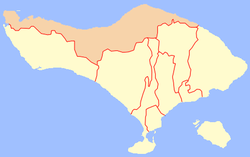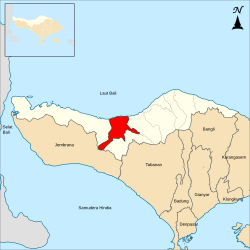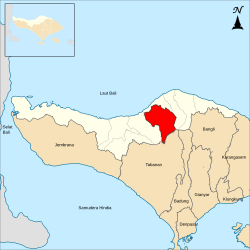Buleleng Regency
Regency in Bali, Indonesia From Wikipedia, the free encyclopedia
Buleleng, officially Buleleng Regency (Balinese: ᬓᬩᬸᬧᬢᬾᬦ᭄ᬩᬸᬮᭂᬮᭂᬂ, romanized: Kabupatén Buléléng;
Indonesian: Kabupaten Buleleng), is a regency (kabupaten) of Bali Province, Indonesia. It stretches along the north side of the island of Bali from the Bali Strait in the west (separating Bali from East Java) almost to the eastern end of the island. It has a land area of 1,322.68 km2 and a population of 624,125 at the 2010 census[2] and 791,910 at the 2020 census;[3] the official estimate as of mid-2024 was 828,156 (comprising 417,978 males and 410,178 females).[1] Its regency seat is in the town of Singaraja, whose urban area extends to the whole of Buleleng District.
Buleleng Regency
Buléléng | |
|---|---|
 | |
| Motto: Singa Ambaraja | |
 Location within Bali | |
| Country | Indonesia |
| Province | Bali |
| Capital | Singaraja |
| Government | |
| • Regent | Putu Agus Suradnyana |
| Area | |
• Total | 1,322.68 km2 (510.69 sq mi) |
| Population (mid 2024 estimate)[1] | |
• Total | 828,156 |
| • Density | 630/km2 (1,600/sq mi) |
| Demographics | |
| • Ethnic groups | Balinese Bali Aga |
| • Religion | Hinduism (Balinese Hinduism • folk Hinduism) |
| • Languages |
|
| Time zone | Indonesia Central Time |
| Area code | (+62) 362 |
| Website | bulelengkab.go.id |



Buleleng was founded as a kingdom by Gusti Panji Sakti, who ruled c. 1660-c. 1700. He is commemorated as a heroic ancestor figure who expanded the power of Buleleng to Blambangan on East Java.[4] The kingdom was weakened during its successors and fell under the suzerainty of the neighbouring Karangasem kingdom in the second half of the 18th century. It was headed by an autonomous branch of the Karangasem Dynasty in 1806–1849.
The Dutch attacked Buleleng in 1846, 1848, and 1849, and defeated it on the last occasion.[5] Buleleng was incorporated into the Dutch colonial system and lost its autonomy in 1882. In 1929 a descendant of Gusti Panji Sakti, the renowned scholar Gusti Putu Jelantik, was appointed regent by the Dutch. He died in 1944, during the Japanese occupation of the Dutch East Indies. His son was a well-known novelist, Anak Agung Nyoman Panji Tisna. In 1947, Anak Agung Pandji Tisna surrendered the throne to his younger brother, Anak Agung Ngurah Ketut Djelantik, known as Meester Djelantik, until 1950. In 1949-50 Buleleng, like the rest of Bali, was incorporated into the unitary republic of Indonesia.
Administrative districts
Summarize
Perspective
The regency is divided into nine districts (kecamatan), tabulated below with their areas and population totals from the 2010 census[2] and the 2020 census,[3] together with the official estimates as of mid-2024.[1] The table also includes the number of administrative villages in each district (totaling 129 rural desa and 19 urban kelurahan), and its postal codes.
The administrative centres of each district have the same name as the district itself, except for the Buleleng District (of which the centre is Singaraja, which also serves as the administrative capital of the whole Regency) and Sawan District (of which the centre is Sangsit).
For convenience the table is divided into two geographical groups, a western group of four districts covering 61% of the land area but with just 41% of the population, and an eastern group of five districts with 39% of the land area and a faster-growing 59% of the population.
| Kode Wilayah | Name of District (kecamatan) | Area in km2 | Pop'n census 2010 | Pop'n census 2020 | Pop'n estimate mid 2024 | No. of villages | Post codes |
|---|---|---|---|---|---|---|---|
| 51.08.01 | Gerokgak (a) | 405.74 | 78,825 | 97,552 | 103,158 | 14 | 81155 |
| 51.08.02 | Seririt | 123.10 | 69,572 | 93,412 | 94,880 | 21 (b) | 81153 |
| 51.08.03 | Busungbiu | 140.65 | 39,719 | 52,690 | 52,830 | 15 | 81154 |
| 51.08.04 | Banjar | 137.85 | 68,960 | 86,205 | 88,034 | 17 | 81152 |
| sub-totals | Western group | 807.35 | 257,076 | 329,859 | 338,902 | 67 | |
| 51.08.05 | Sukasada | 160.96 | 72,050 | 89,774 | 95,223 | 15 (c) | 81161 |
| 51.08.06 | Buleleng | 46.25 | 128,899 | 150,211 | 155,561 | 29 (d) | 81111 -81119 |
| 51.08.07 | Sawan | 91.29 | 58,578 | 80,174 | 85,566 | 14 | 81171 |
| 51.08.08 | Kubutambahan | 118.47 | 53,765 | 68,778 | 74,411 | 13 | 81172 |
| 51.08.09 | Tejakula | 98.35 | 53,757 | 73,017 | 78,493 | 10 | 81173 |
| sub-totals | Eastern group | 515.33 | 367,049 | 461,954 | 489,254 | 81 | |
| Totals | 1,322.68 | 624,125 | 791,813 | 828,156 | 148 |
Note: (a) Gerokgak District includes the offshore island of Pulau Menjangan Kecil. (b) includes the kelurahan of Seririt, plus 20 desa.
(c) includes the kelurahan of Sukasada, plus 14 desa. (d) comprises 17 kelurahan and 12 desa.
- Map of Buleleng Regency in Bali
- Map of districts in Buleleng Regency
List of districts and villages in Buleleng Regency as follows:
| Code | Districts | Urban villages | Rural villages | Status | List |
|---|---|---|---|---|---|
| 51.08.04 | Banjar | - | 17 | Desa |
|
| 51.08.06 | Buleleng | 17 | 12 | Desa |
|
| Kelurahan |
| ||||
| 51.08.03 | Busung Biu | - | 15 | Desa |
|
| 51.08.01 | Gerokgak | - | 14 | Desa |
|
| 51.08.08 | Kubutambahan | - | 13 | Desa |
|
| 51.08.07 | Sawan | - | 14 | Desa |
|
| 51.08.02 | Seririt | 1 | 20 | Desa |
|
| Kelurahan | |||||
| 51.08.05 | Sukasada | 1 | 14 | Desa |
|
| Kelurahan |
| ||||
| 51.08.09 | Tejakula | - | 10 | Desa |
|
| TOTAL | 19 | 129 |
- Districts in Buleleng regency (west to east)
- Gerokgak district
- Seririt district
- Busung Biu district
- Banjar district
- Sukasada district
- Buleleng district
- Sawan district
- Kubutambahan district
- Tejakula district
Airports
Lt.Col. Wisnu Airfield is located in the Sumberkima village.
Research on a new airport was completed in 2017, due to the congestion of Ngurah Rai International Airport. The new two-runway airport will be built in the east part of Buleleng Regency and will be connected by railway to the existing airport.[6] Kubutambahan, 15 kilometers east of Singaraja, was decided to be the new airport site over two other candidates, Sangsit and Gerokgak, after taking into account geographical conditions, wind speed, wind direction, and other factors.[7]
History
The territory of Pedawa, one of the 62 Bali Aga villages in the island,[8] is the depository of several sarcophagi present at Ingsakan, Banjar Asah, Lebahlinggah, and Tampug. There are also three types of megaliths used in religious rituals and known as taulan (small stones used as symbols of Ida (God) - equivalent to Arca -, found in all main temples of Pedawa village); gainan (a stacked stone located at the Munduk Madeg Temple in Pedawa village), and umah taksu (a stacked stone similar to punden terraces in some areas of Pedawa village). Each of these items is witness to the ancient creation of the village, taking it into Prehistoric times[9] They come in par with the megaliths collected in various parts of Bali and gathered at Sanur stone park.[10]
Pearl producers
Many big pearl producers have developed 130.9 hectares in Gerokgak village as an area for pearl breeding and world-class pearl production. It will enlarge to 250 hectares swath of water stretching from Gerokgak to Kubutambahan.[11]
Gallery
- Two warriors in Buleleng, 1865
- Balinese and Papuan slaves of the Rajah of Buleleng, 1865

See also
References
External links
Wikiwand - on
Seamless Wikipedia browsing. On steroids.














